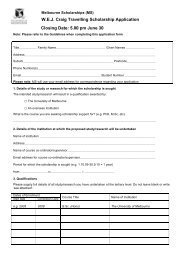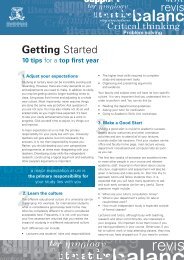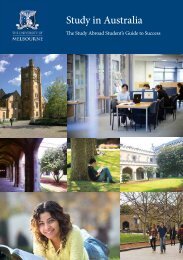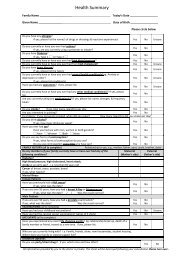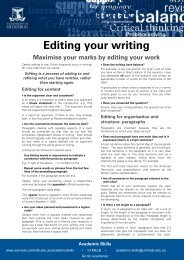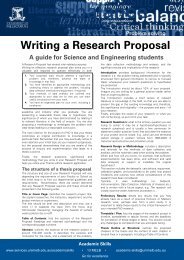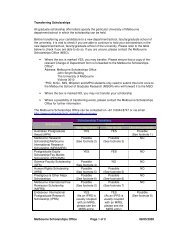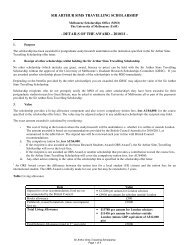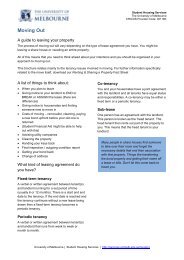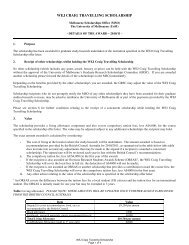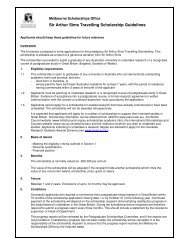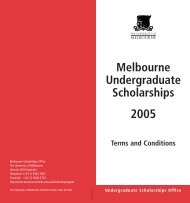a growing experience - Student Services - University of Melbourne
a growing experience - Student Services - University of Melbourne
a growing experience - Student Services - University of Melbourne
Create successful ePaper yourself
Turn your PDF publications into a flip-book with our unique Google optimized e-Paper software.
HEALTH AND WELL-BEING OF INTERNATIONAL STUDENTSabuse, and presumably different degrees <strong>of</strong> seriousness <strong>of</strong> abuse, the average reactionto each <strong>of</strong> the four forms <strong>of</strong> abuse does differ. The highest level <strong>of</strong> distress is shownby those who are physically abused, a finding that is not surprising. The nextstrongest reaction is to exclusion. The responses to verbal abuse and sexualharassment are similar and almost at the level <strong>of</strong> those to exclusion. It might bethought surprising that distress in response to exclusion is as strong as it is, relative toresponses to verbal abuse and sexual harassment. Perhaps the kinds <strong>of</strong> emotionsengendered by each <strong>of</strong> these forms <strong>of</strong> distress (anger as opposed to hurt and damagedself-esteem) have something to do with this. Perhaps exclusion is seen as a morepersonally directed form <strong>of</strong> abuse.Abuse can also lead to feelings <strong>of</strong> insecurity and lack <strong>of</strong> safety. There is evidence <strong>of</strong>this in the data. Those who have <strong>experience</strong>d abuse feel significantly less safe in<strong>Melbourne</strong> than those who have not. This undoubtedly increases the lack <strong>of</strong> wellbeing<strong>of</strong> these students, as well as reverberating among the friends and acquaintances<strong>of</strong> those who have been abused.Abuse can come from many different sources and be the result <strong>of</strong> a variety <strong>of</strong>motivations. Of concern here is the question <strong>of</strong> whether the abuse <strong>experience</strong>d byinternational students is culturally motivated. The items in the questionnaire do nottarget culturally motivated discrimination. This means that students might bereporting abuse from strangers, acquaintances, employers, or even family members.The abuse is not confined to on-campus incidents. The results show that students whohave reported abuse have significantly stronger perceptions <strong>of</strong> being treateddifferently in Australia because <strong>of</strong> their cultural background than those who have not.The heightened awareness <strong>of</strong> discriminatory treatment <strong>of</strong> the abused students could bethe result <strong>of</strong> the abuse. On the other hand, it might be that those who are moresensitive to discriminatory treatment are more likely to interpret events as abusive.The actual rates <strong>of</strong> reported abuse show little difference on the basis <strong>of</strong> countrycategory or cultural background. Physical abuse and sexual harassment do not seemto be significantly associated with cultural background. <strong>Student</strong>s from Asiancountries, especially Malaysian and Singaporean students, report higher rates <strong>of</strong>exclusion than expected on the basis <strong>of</strong> a null hypothesis. <strong>Student</strong>s from Malaysiaand Singapore also report higher rates <strong>of</strong> verbal abuse than expected. On the otherhand, students from PR China <strong>experience</strong> less verbal abuse and exclusion thanexpected. <strong>Student</strong>s from non-Asian countries, especially European and Englishspeakingcountries, also report lower rates <strong>of</strong> exclusion than expected. Although thereis some tendency for the rates <strong>of</strong> abuse to relate to cultural background, it is by nomeans strong, clear and consistent. This is reinforced by the finding that there are nosignificant differences in the Abuse and Distress scale score based on countrycategory or the Asian/non-Asian country dichotomy.There is a strong and significant gender difference in the <strong>experience</strong> <strong>of</strong> abuse bystudents. This can be seen in both the rates <strong>of</strong> abuse <strong>of</strong> different types as well as inthe response to abuse. Although there is little difference in rates <strong>of</strong> reportedexclusion, women report significantly higher rates <strong>of</strong> physical and sexual abuse thanmen, while men report significantly higher rates <strong>of</strong> verbal abuse. The difference isgreatest for sexual harassment, where 72 <strong>of</strong> the 76 who have been sexually harassedare women; 12.1 per cent <strong>of</strong> female respondents compared with 1.9 per cent <strong>of</strong> malerespondents have been sexually harassed. There is also a strong and significantgender difference in the level <strong>of</strong> distress <strong>experience</strong>d or reported in response to abuse,Rosenthal, Russell & Thomson, 2006 143



